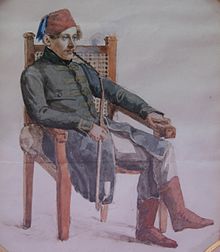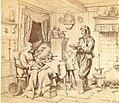Rudolf Jordan (painter)



Wilhelm Rudolph Jordan (born May 4, 1810 in Berlin , † March 20, 1887 in Düsseldorf ) was a German painter.
Life
After training with Karl Wilhelm Wach (1787–1845), who had founded a painting school in Berlin in 1819, Jordan was a student and master class student at the Düsseldorf Art Academy (1833–1840). After that, he worked at Friedrich Wilhelm Schadow (1789-1862) and Karl Ferdinand Sohn (1805-1867) and had from 1848 as a genre painter his own studio in Dusseldorf on Wehrhahn 9. Here he trained students from, and got a royal honorary professor awarded .
In 1830 he made his first nature studies on Rügen. It was there that his first genre painting was created: The fisher family . From 1837 he was a member of the Prussian Academy of the Arts in Berlin, section for the fine arts. He was a royal professor and in possession of the large gold medal from the Berlin exhibition.
He is considered to be the founder of the ethnographic genre that was very popular in Düsseldorf, and he painted life on the North Sea coast. In a certain sense, he followed the fashion of the times, which in the literary field was expressed, for example, in Heinrich Heine's travel description “The North Sea”. In 1843 his painting Marriage proposal on Heligoland (National Gallery in Berlin) was successful. From then on he devoted himself exclusively to the description of the life of a fisherman and boatman, for which he fetched the material on frequent trips to Holland, Belgium and France. In 1855 another successful picture followed, that of the wedding on Heligoland . The hard-working coastal dwellers were ideal romantic figures in Jordan's paintings. He portrayed both humorous and serious, even tragic scenes. His coloring was strong at the beginning and only became a little weaker in the end. He also became known for depictions from Italian folk life. Many of Jordan's paintings are widely used through engraving, lithography, etc. He has also made a name for himself as a watercolor painter, illustrator and eraser.
Jordan was one of the founders of the Crignic Composition Association in 1844 and of the Malkasten Artists' Association in Düsseldorf in 1848, to which he belonged until his death. He was also a member of the Association of Düsseldorf Artists for Mutual Aid . In the revolutionary year of 1848 he was a platoon leader of the Düsseldorf vigilante under Captain Lorenz Clasen .
A year before his death, Jordan was awarded the Royal Prussian Order of the Crown II. Class at the beginning of the Berlin Jubilee Exhibition in 1886 , after he had received the Order of the Red Eagle III in 1869 . Class and from Sweden the Commander's Cross of the Wasa Order II. Class had received.
Students were u. a .:
- Anton Dieffenbach (1831-1914)
- Emil Ebers (1807-1884)
- Ernestine Friedrichsen (1824-1892)
- Julius Geertz (1837–1902)
- Otto Günther (1838-1884)
- Minna Heeren (1823–1898)
- Joseph Hoegg (1818–1885)
- Albert Kindler (1833–1876)
- Auguste Ludwig (1834–1901)
- Heinrich Ludwig Philippi (1838–1874), history painter and husband of his niece
- Georg Reimer (1828–1866), genre painter
- Henry Ritter (1816–1853), initially a private student, then a close friend
- Raphael Ritz (1829-1894)
- Jules Ruinart de Brimont (1836–1898)
- Felix Schlesinger (1833–1910), is one of the best-known painters of children's motifs, who were sought internationally as early as the 19th century and collected mainly in England and America
- Emil Gottlieb Schuback (1820–1902)
- Georg Schwer (1827–1877)
- Paul Eduard Richard Sohn (1834–1912)
- Hermann Sondermann (1832–1901)
- Benjamin Vautier (1829–1898)
- Wilhelm Wallander (1821-1888)
- Victor Zeppenfeld (1834-1883)
family
Jordan was a son of André Charles Guillaume Jordan (born September 29, 1778 in Berlin; † June 25, 1850 ibid), judicial councilor in Berlin, and Wilhelmine Hielkert. He was a descendant of Charles Etienne Jordan (1700–1745), the advisor and close confidante of Frederick the Great. Jordan was first married to Sofie von Mülmann (1811–1863), also a painter, sister of the councilor Otto von Mülmann . Sofie's sister, Emilie von Mülmann (1805–1884), was married to the painter Karl Ferdinand Sohn . The second wife of Jordan was Marie von Hanstein (1825-1885). The first marriage had three children. Jordan was buried in the Nordfriedhof in Düsseldorf. The clay model for the portrait plaque on his tombstone was created by the painter Ernst Bosch . Jordan's sister Marie (* 1816 in Berlin; † 1899 there) was married to his friend, the painter Adolf Henning .
Works (selection)

- A marriage proposal on Heligoland , 1834 - This picture was exhibited in Berlin in 1834 and caused a sensation. An old pilot stands broadly in front of his hut, pipe in hand, and speaks to a young prostitute, his daughter. She has pulled up her apron with one hand and looks embarrassed at the floor, because her father advertises a young fisherman who is standing in front of her and whom the old man holds under the chin encouragingly. In the background you can see fishermen busy with their boats on the beach. The picture can be described as a landmark in German genre painting. The humorous and so simple object, these strong and lively figures, this naturalness in posture and expression, this fresh and healthy coloring and the drawing that was meticulous down to the smallest detail - they met with immeasurable approval at the time and made the creator of the picture famous in one fell swoop. "The fresh, coarse humor that speaks from this delicious genre image", says Adolf Rosenberg , "formed a welcome contrast to the sweet marzipan painting of the Wach school on the one hand and to the whiny sentimentality of the rest of Düsseldorf on the other hand." The consul Wagener in Berlin acquired the picture for his collection, with which it later came to the National Gallery. The marriage proposal on Heligoland has achieved seldom popularity, the subject was repeated by other painters in many variations, the picture itself was spread everywhere through mass reproductions in engraving, lithography, etc. It became, so to speak, a fashion picture, which was especially preferred as a motif for living pictures.
- A Greek defending his family , cardboard and color sketch, 1830
- The Returning Pilots , 1836, Berlin National Gallery
- The pilot storm bell , 1837
- Storm bells on Heligoland , 1839, Langes Tannen Museum, Uetersen
- The pilot's exam , 1842 - Jordan had already sketched and etched the picture in 1839 with a slightly different drawing; It was engraved in copper in 1850 by Wilhelm Oelschig as a club journal for the Kunstverein for Rhineland and Westphalia, and it became very popular.
- Rescue from the shipwreck , 1848
- Praying women with their clergy in a storm , 1852
- A wedding on the island of Marken , 1854
- Wedding on Heligoland , 1855
- The Sick Soup , 1862, Kunsthalle Düsseldorf
- The Altmännerhaus on the Dutch coast , 1864, National Gallery in Berlin
- The widow's consolation , 1866, National Gallery in Berlin
- Soup day in the monastery , 1868, Wallraf-Richartz-Museum in Cologne
- Lifeguard station , 1868
- The women's shelter in Amsterdam , 1868
- Prisoner at Chillon Castle , 1869
- Stranded passengers / castaways in the beach bar (1872)
- The burial of the old seaman , 1874, exhibited in Munich, Bremen and Hamburg in the same year
- After an awake night , 1874; 2nd version: 1878
- Shipwreck on the Normandy coast , 1880
- Return from herring fishing , 1881
- Dutch beach bar , 1884
- also a large number of family scenes
Illustrations (selection)
Digitized edition of the University and State Library Düsseldorf :
- In: Album of German artists in original etchings. - Buddeus, Düsseldorf 1841. Digitized edition
- In: Aquarelle Dusseldorf artists: dedicated to the art-loving women. - Arnz, Düsseldorf 1861. Digitized edition
- In: German seals with marginal drawings by German artists. - Buddeus, (Volumes 1–2) Düsseldorf 1843. Digitized edition
- In: German proverbs and speeches in pictures and poems. - Arnz, Düsseldorf 1852. Digitized edition
- In: Howitt, Mary Botham. The Dusseldorf artist's album. - Arnz, Dusseldorf 1854. Digitized edition
- In: Düsseldorfer Lieder-Album: 6 songs with piano accompaniment. - Arnz, Düsseldorf 1851. Digitized edition
- In: Reinick, Robert. Songs by a painter with drawings by his friends on the margins. - between 1836 and 1852.
- Songs by a painter with drawings by his friends on the margins. - Schulgen-Bettendorff, Düsseldorf 1838, colored portfolio edition. Digitized edition
- Songs by a painter with drawings by his friends on the margins. - Schulgen-Bettendorff, Düsseldorf 1838. Digitized edition
- Songs by a painter with drawings by his friends on the margins. - Buddeus, Düsseldorf between 1839 and 1846. Digitized edition
- Songs by a painter with drawings by his friends on the margins. - Vogel, Leipzig approx. 1852. Digitized edition
- In: Stieler, K./Wachenhusen, H. / Hackländer, FW: Rheinfahrt. From the sources of the Rhine to the sea. - Kröner, Stuttgart 1875. Digitized edition
- In: Musäus, Johann Karl / Klee, Julius Ludwig (ed.). Folk tales of the Germans. With woodcuts based on original drawings. - Mayer and Wigand, Leipzig 1842. Digitized edition
- Etchings, drawings, etc.
In the locker room of Chillon Castle - illustration in the journal Die Gartenlaube , 1877
literature
- Jordan, Rudolf. In: Friedrich von Boetticher: painter works of the 19th century. Contribution to art history. Volume 1/2, sheets 31–61: Heideck – Mayer, Louis. Ms. v. Boetticher's Verlag, Dresden 1895, pp. 621-625 ( archive.org ).
- FW Ross: Rudolf Jordan, the painter of Heligoland, at one time genre painter and professor in Düsseldorf. Self-published, Hanover 1900. With 16 illustrations on plates. 32 p., 1 sheet Kl.-8vo. Silver pr. OLwd. Description of his art and private life with portraits, replicas and reviews of his better-known paintings.
- Rudolf Wiegmann : The Royal Art Academy in Düsseldorf. Your history, establishment and effectiveness . Düsseldorf, 1856
- Wend von Kalnein : The Düsseldorf School of Painting. Verlag Philipp von Zabern, Mainz / Rhein 1979, p. 363, illus. P. 363, catalog no. 128.
- Gerhard Kaufmann, Manfred Meinz , Jürgen Meyer, Hildamarie Schwindrazheim: From Hamburg to Helgoland. Art and culture in the 19th century. Hamburg 1967, p. 70, catalog no.146.
- Hans Paffrath (Ed.): Lexicon of the Düsseldorf School of Painting 1819–1918. Volume 2: Haach – Murtfeldt. Published by the Kunstmuseum Düsseldorf in the Ehrenhof and by the Paffrath Gallery. Bruckmann, Munich 1998, ISBN 3-7654-3010-2 , pp. 193-196 (fig.).
- Jordan, Rudolf. In: Hermann Alexander Müller : Biographical Artist Lexicon. The most famous contemporaries in the field of fine arts of all countries with details of their works. Bibliographisches Institut, Leipzig 1882, p. 286 f.
- Jordan, Rudolf . In: Hans Vollmer (Hrsg.): General lexicon of fine artists from antiquity to the present . Founded by Ulrich Thieme and Felix Becker . tape 19 : Ingouville – Kauffungen . EA Seemann, Leipzig 1926, p. 161-162 .
Web links
- Rudolf Jordan , data sheet in the portal rkd.nl ( Rijksbureau voor Kunsthistorische Documentatie )
Individual evidence
- ↑ Jordan Wilh. Rudolf, Maler, Wehrhahnen 9 In: Address book of the mayor's office in Düsseldorf. 1855, p. 63.
- ↑ Jordan, Rudolf, Prof. and painter, Wehrhahn 9 In: Address book of the Lord Mayor's Office Düsseldorf for 1879. P. 73.
| personal data | |
|---|---|
| SURNAME | Jordan, Rudolf |
| ALTERNATIVE NAMES | Jordan, Wilhelm Rudolph |
| BRIEF DESCRIPTION | German painter |
| DATE OF BIRTH | May 4, 1810 |
| PLACE OF BIRTH | Berlin |
| DATE OF DEATH | March 20, 1887 |
| Place of death | Dusseldorf |










